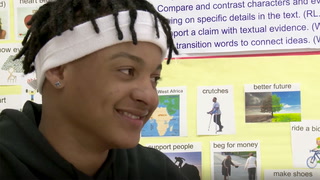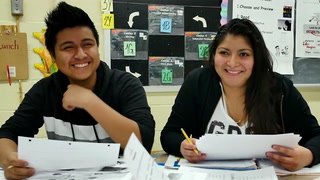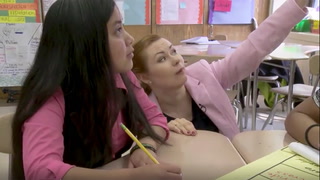Literacy Centers for Multilingual Students Transcript
Carolina: Can you tell me one piece of information about ...
Suzanna: My name is Suzanna McNamara and I am the director of Curriculum Development, at Bridges to Academic Success. By New York state definition, SIFE are students with interrupted or inconsistent formal education and these are newly-arrived, English language learners who, for various reasons, have had compromised schooling in their home country.
Carolina: Please take your binders, everybody [inaudible 00:00:43].
Suzanna: We use the term SIFE with developing literacy to refer to a subset of the larger SIFE population. Rather than just two years below grade level and home language literacy, SIFE with developing literacy have home language literacy levels at or below third grade.
Carolina: People live in the desert.
Speaker 3: People live in the desert.
Carolina: What can you say?
Suzanna: Unlike the integrated ENL/ELA class, which really focuses mostly on language/arts content, the standalone ENL class really targets those foundational reading and writing skills that are the absolute building blocks to higher levels of literacy.
Carolina: Floor. Good job. Floor.
Suzanna: The standalone ENL class for SIFE with developing literacy is the center space model where students are rotating through various centers.
Carolina: My name is Carolina [inaudible 00:01:32], I'm a teacher of English as a New Language and ELA here at Newtown High School, Queens, New York.
What did we learn in our centers yesterday? I want to hear ...
Today the students will be working in four centers. One is reading, one is writing, one is foundational literacy and the [inaudible 00:01:55] one. The students need to know what they need to do at each center.
Students who will be working on [inaudible 00:02:00] sentence, I would like you to practice reading sight words with speed, [foreign 00:02:06], right? With flash cards. And then show it to your partner, also fast. Please, follow the protocol, organize your papers in your binders, work independently. In twenty minutes, we're going to rotate. Alright, please, take your places at the centers.
In center one, I'm teaching my students conferencing today. So they read a book and after that, they have to do inferences based on what they've read and based on visuals that they've seen the texts.
Can you look trough the pictures and tell me what do you think this book is going to be about?
Suzanna: Center one is the focus of all instruction. It's the one center that throughout the year where the teacher remains and is teaching daily groups, sometimes two groups a day, in a very close, intimate setting where students are grouped based on shared skills or strategies that they need to work on in order to move to the next level.
Carolina: Alright, so what do you think the book is going to be about?
Speaker 2: No water.
Carolina: No water.
Speaker 2: No trees.
Carolina: No tress. What would you say? Very what? Very hot.
All good readers need to make inferences when they read.
So I see something in the book, and then I think about it and I make an inference. I read deserts have lots of sun, they are hot. So I think, "Maybe it's very difficult to live in the desert because it's so hot."
Suzanna: What the instruction looks like is the teacher has selected a text that students are reading and within that text the teacher is modeling a specific skill strategy. It could be a foundational skill, like sight words or phonics, it could be a comprehension skill or strategy and she is gradually releasing that to students.
Carolina: Go in, come out. The cat goes in, the cat comes out.
Speaker 2: Girl, girls.
Carolina: For example "ground", right? Under the ground ...
My decision about center one is usually based on my observations. As I walk around watching how the students are reading and how they're working, I determine what prevents them from moving to the next level. And second of all, I use the progress monitoring tool that helps me determine what their current level is.
Look at the pictures, look at the sentence and then write and inference. I think ... I would like you to use a structure like this, "I think ..." Because the picture shows, because the text says, I would like you to make inferences. Who else needs water? And how do we get water in the desert?
Speaker 5: From plants.
Carolina: Yes, so this is inference. It's not here, but this is what you think, right Jennifer?
Speaker 2: ... in too plants.
Carolina: Show me the picture that you make inference about and tell me what did you think.
Speaker 2: I think this animal live in this plants but have a ...
Carolina: [foreign 00:05:30], shade. They need shade. When we go to our reading center, we're going to do this. We're going to read and make inferences. What was the book about?
Speaker 2: Desert.
Carolina: Desert. Now what do you remember? Hot?
Speaker 2: Desert, people in the desert.
Carolina: People live in the desert. What else?
After they have read the text, they created this mind map and then they took this mind map and turned it into a paragraph.
We're going to write about our book and I want to use some of my sight words, "is", "some". So notice how I don't start each sentence from a new line, right? I just continue, like a paragraph.
In essence, center one was like a connection between all the three centers that are going on in class every day.
Alright, guys, let's move. Let's put your papers in the binders and we're moving to the reading center.
Reading stamina is one of the things that SIFE students need to learn.
Speaker 2: [inaudible 00:06:53] care ...
Carolina: And there's several factor that help students develop stamina. First of all, having a great library. So the books that they're reading are very high-interest books. They're not childish, they range from close to home topics like soccer or baseball or something they could relate to academic subjects.
So this are high literacy books, great in visual. And students love reading, they love looking at them.
Speaker 2: We would end in [inaudible 00:07:38] [foreign 00:07:39].
Speaker 5: My book is about cars. I like the cars [inaudible 00:07:49].
Carolina: For students to truly be good readers, patient readers, you need to start with eyes on text for three minutes and then slowly increase it to ten minutes so they practice the habit of a good reader.
At the writing center, there are three writing tasks that I divide for my students. First, they have to write about the book that they've been reading. Using the map maps that they've developed at the reading center, they use sight words, [inaudible 00:08:33] practice the foundational literacy center to create sentences about the book. I even provide sentence starters like, "What I like about my book is ..." or "One thing that I've learned is ..."
The second assignment is that students need to generate sentences based on the visual. At first, the pictures are just descriptive. They just have to say what do they see, what are people doing and so on. As they become better writers and better readers, as their vocabulary increases, I select pictures that has some sort of plot around them, that there's a story that you could see. And then I prompt them to make a story.
Speaker 6: [crosstalk 00:09:31] I see [foreign 00:09:45].
Carolina: So Mohamed, what I want you to do is I want you to come up with ideas, things, actions, feelings and thoughts. And then I want you to share your ideas with Zoila. Alright? And maybe Zoila can give you some more ideas. And then [inaudible 00:09:57].
So when they come to the writing center they often have a choice, what they want to write today.
Suzanna: The foundational skill center is critical in the center's model. It's the place where students are practicing the nuts and bolts of the word level skills that they're really not getting in any other class in secondary school. So they're working specifically on two major types of word deciphering skills. One is sight words, where they're learning to look at a very high frequency word, the kind of words that make up of the bulk of text we read.
Speaker 2: Man, [foreign 00:10:36], boy [foreign 00:10:37].
Suzanna: And they're learning how to recognize those as whole units, quickly. And the other way they're learning how to read words is through phonics, so they're learning how to identify and detect patterns in words.
Speaker 6: I can find [inaudible 00:10:51].
Carolina: The protocol for foundational literacy center is usually laid out during the initial twenty startup lessons.
Speaker 3: [foreign 00:11:09]
Carolina: And every student has a different need. This program allows me to identify that and teach it explicitly to them in a small group instruction.
Yes, like always. [foreign 00:11:26]
As I walk around, I can immediately pinpoint what prevents them from reading better, from increasing fluency, and from comprehending what they're reading.
Zoila, I checked your binder and you're doing very good. Your writing is really good.
During the conferencing, we often go over the requirements for each reading level and I check their reading to determine, have they moved forward?
Now, what I would like you to do in writing is instead of using I see ...
This is very important in this class. The students need to know about how they're doing and what prevents them from doing better.
To move to the next level, you need to know most of this sight words. Rachel, let's check. We're going to read, right? Together.
Speaker 3: [inaudible 00:12:26] learn, live, love, [inaudible 00:12:20].
Carolina: Good, I like that you corrected yourself. As you practice your sight words in your group, put a check mark next to the words that you already know, okay? Because our task is not only to read them fast, but also to know what they mean, alright? Good work, Zoila.
Alright, guys. I just want to tell you guys you did an excellent job today. Students who worked with me at center one, excellent inferences. I liked how you used your language with each other.
I was a little bit reticent about teaching conferencing to my first grade readers. I felt like they don't have enough language to really be able to make inferences based on the texts, but it turned out that I was wrong. They had enough language and thinking skills to be able to make excellent inferences. They've made better inferences that I even anticipated. It was a lesson for me that you can't underestimate your students. They will always surprise you.
















18 Comments
Monica Espinoza Nov 18, 2018 12:10am
Wow! Commendable job you are doing with your English learners students. By the way, I attended Newtown HS from 1981- 1983. Your classroom and you brought beautiful memories as I was watching your video.
Maria Granado Sep 30, 2018 10:10pm
Can I ask you how you use the binders? Do the students keep all their work in them as they rotate centers?
Michelle Leip Sep 17, 2018 11:18am
Thank you for sharing! What curriculum/resources do you use to set up the stations?
Kimbley Fisher Sep 11, 2017 11:12pm
Andrew Martin Sep 6, 2017 11:05am